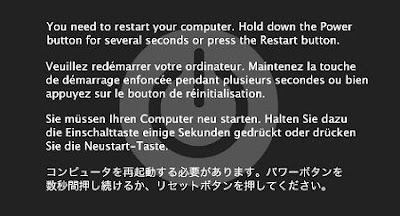when you boot your hackintosh you can press "F8" before you see the gray apple boot screen.


when you boot your hackintosh you can press "F8" before you see the gray apple boot screen.


MAC OS X Leopard includes built-in Text-To-Speech engine, it allows the mac to talk back to you any written text.
another feature that is absent (i don't really need it) from mac but exist in windows is the right-click "New some_file_type..."

there is a hidden minimize effect on the dock it is named 'Suck' (maybe that is why it didn't got to production) in order to activate it open terminal and write:
the most absent feature in mac is the right click->cut (on files and folders),

when you install your hackintosh you get a leopard OS X of a certain version i got mine from uphack iAtkos 10.5.1 yours might be different, check what version you have using the "About" dialog (from the menu bar apple press "About this Mac")
once you know what version you have, and if you have PC_EFI installed (EFI emulation, read here on how to check).
lets look at the 10 steps:
1. first download the update from apple at this address. (DO NOT use Software Update it will not work!!)
2. backup your /System/Library/Extensions folder just in case restore is needed (i didn't need any restore)
3. open terminal and write these commands:
sudo -s
enter your password and press enter
while sleep 1 ; do rm -rf /System/Library/Extensions/AppleIntelCPUPowerManagement.kext ; done
(this line should not return to prompt since this is a loop script)
it will check every 1 second if a file named: "AppleIntelCPUPowermanagement.kext " is found in the extension folder and when it appears it will delete it, the script will run and not return to prompt (do not kill/close it yet), if you wish to verify it is working, create new folder and rename it to: "AppleIntelCPUPowermanagement.kext " and then copy it to /System/Library/Extensions, it should be immediately deleted
4. install the downloaded package and let it finish
5. when the install end DO NOT press restart yet!
6. now stop the script by pressing control and C (ctrl+C)
7. next you need to edit the apple restart script that checks if this is a hackintosh and decides if to start the system or display and error screen, you will tell the system to load directly to leopard, do this by:
cd /System/InstallAtStartup/scripts
and edit the script named '1'
vi 1
8. now the console will display the content of the file, using arrows scroll down to the end there you will find a line like this near the end:
kextload /System/Library/Extensions/Dont Steal Mac OS X.kext
press I (stands for insert) to enter edit mode
9. delete the value:
/System/Library/Extensions/Dont Steal Mac OS X.kext
and replace it with this value:
/System/Library/Extensions/dsmos.kext
press Esc to exit edit mode and press : to enter vi prompt and then write !w (stands for write changes to disk even if file is read only) and press enter, after that press : and write q (stands for quit) and by that you exit the vi.
10. now if you see any changed kext (in the /System/Library/Extensions folder, you can sort by date and see the latest from the update), if you want to change them back to your kext then you may restore them from previous backup step and finally press the Restart button on the install screen.
after restart it will boot to boot screen and perform another restart (without loading the leopard GUI), then it will boot into the blue screen (before login window) and will stay there for 3-4 minutes then the login window will appear and now you have 10.5.2 installed.
check the about dialog should look similar to this:
you should be also seeing the 10.5.2 trademark feature in the stacks (list view):
you can find fix and fatures list for this version here, and original Netkas post here.
Enjoy

hackintosh comes in two flavors of install types: one with EFI emulation (A.K.A PC_EFI) and another without,

found a way to change the about dialog, while digging this whole pkg install and uninstall thing, you can learn a lot from it about the way the system is built and how to tweak it.



the login screen background is found here:
there is yet another problem with hackintosh and bluetooth (at least one i experience), the symptoms are: when you finished booting the bluetooth icon in the icon bar is disabled












com.apple.blued.launchd
i have compiled a list of sites i found with links to Mac files (rapidshare/torrents/magaupload/etc.)
i found something amazing, google earth got a flight sim in it, just fire up google earth (there is a mac version and can be downloaded from: here)




